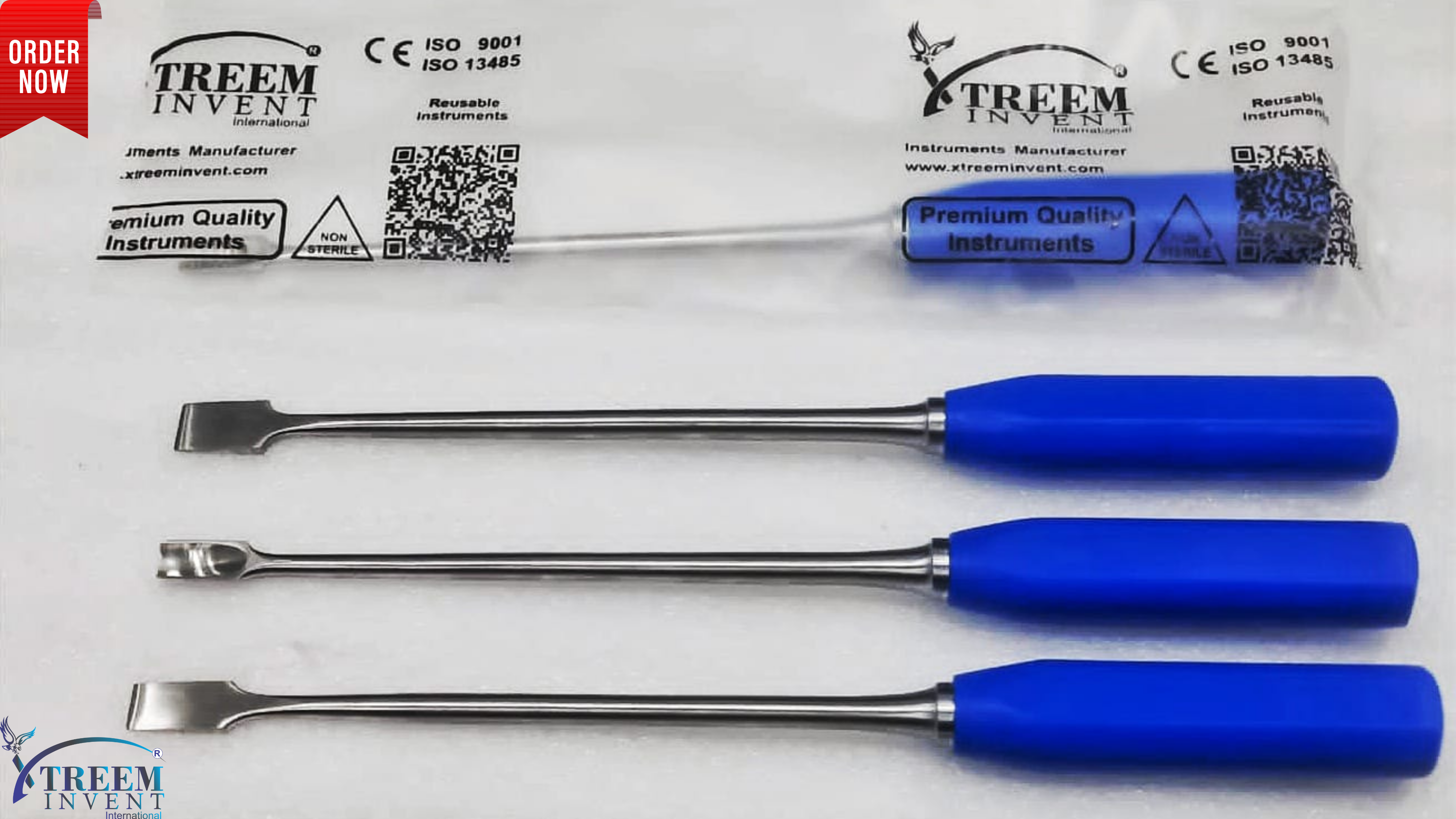Long Shaft Spinal Chisels

In the intricate world of spine surgery, precision and control are paramount. Surgeons rely on a variety of specialized instruments to perform delicate procedures that require meticulous attention to detail. Among these essential tools are spinal chisels with long shafts, designed to provide surgeons with the reach and accuracy needed to navigate the complex anatomy of the spine. In this blog, we’ll explore the importance, design, and applications of long-shaft spinal chisels, highlighting why they are indispensable in modern spine surgery.
BUY NOW ON OUR ALIBABA STORE:
WATCH THIS PRODUCT ON OUR YOUTUBE:
What Are Spinal Chisels with Long Shafts?
Spinal chisels are specialized surgical instruments used primarily for shaping or removing bone during spinal procedures. The long shaft of these chisels is specifically designed to access deep and narrow spaces within the spinal column, where precision is crucial. The chisel’s blade is typically sharp and beveled, allowing for clean and controlled bone removal without damaging surrounding tissues.
Key Features of Long Shaft Spinal Chisels
1. Extended Reach for Deep Access
The most distinguishing feature of these chisels is their long shaft, which provides surgeons with the reach needed to access deep-seated areas of the spine. This extended length is particularly useful in surgeries involving the thoracic or lumbar regions, where the spinal structures are located further from the skin surface.
2. Precision Cutting Edge
The blade of a spinal chisel is designed for sharp, precise cuts. The beveled edge allows for smooth bone removal, reducing the risk of splintering or cracking the bone. This precision is vital in spinal surgery, where even minor errors can have significant consequences.
3. Ergonomic Design
Long shaft spinal chisels are ergonomically designed to provide a comfortable grip, ensuring that surgeons can maintain control during lengthy procedures. The handle is typically crafted to reduce hand fatigue, allowing for steady, precise movements throughout the surgery.
4. Durable Construction
Made from high-quality stainless steel, these chisels are built to withstand the rigors of repeated use. The material’s strength ensures that the chisel maintains its sharpness and integrity over time, providing consistent performance in every procedure.
Applications in Spine Surgery
1. Laminectomy
During a laminectomy, a surgeon removes a portion of the vertebral bone called the lamina to relieve pressure on the spinal cord or nerves. Long shaft spinal chisels are essential in this procedure, allowing for precise removal of bone in areas that are difficult to reach with standard instruments.
2. Spinal Fusion
In spinal fusion surgery, the goal is to join two or more vertebrae together to eliminate movement between them, often to treat conditions like scoliosis or degenerative disc disease. Spinal chisels are used to prepare the bone surfaces for graft placement, ensuring a stable and successful fusion.
3. Decompression Surgeries
Spinal decompression surgeries aim to relieve pressure on spinal nerves caused by conditions such as herniated discs or spinal stenosis. Long shaft chisels enable surgeons to carefully remove bone or ligament material that is compressing the nerves, without compromising the integrity of surrounding tissues.
Advantages of Using Long Shaft Spinal Chisels
1. Improved Surgical Access
The long shaft allows for better access to difficult-to-reach areas of the spine, reducing the need for extensive tissue retraction or larger incisions. This can lead to shorter recovery times and less post-operative pain for patients.
2. Enhanced Precision
The sharp, beveled blade of the chisel allows for clean, precise bone removal, which is critical in minimizing the risk of nerve damage or other complications. This precision contributes to better surgical outcomes and patient safety.
3. Versatility in Procedures
Spinal chisels with long shafts are versatile instruments that can be used in a wide range of spinal procedures. Their ability to adapt to different surgical needs makes them an invaluable tool in any spine surgeon’s toolkit.
Exploring the Sizes and Shapes of Long Shaft Spinal Chisels
Long-shaft spinal chisels are indispensable tools in spine surgery, providing the reach and precision needed for intricate procedures. The effectiveness of these instruments is largely determined by their size and shape, which must be carefully selected based on the specific requirements of the surgery. In this blog, we will delve into the various sizes and shapes of long-shaft spinal chisels, explaining how each variation serves a unique purpose in spinal procedures.
Understanding the Sizes of Long Shaft Spinal Chisels
The size of a spinal chisel is crucial to its function, particularly in terms of the shaft length and blade width. These dimensions dictate the chisel’s reach, control, and the type of bone removal it can achieve.
1. Shaft Length
- 150 mm to 200 mm: These shorter shafts are ideal for procedures where the surgical site is closer to the surface, such as in cervical spine surgeries. The reduced length offers greater control and precision in more confined spaces.
- 200 mm to 300 mm: The standard range for most spinal surgeries, these lengths provide a balance between reach and maneuverability. They are commonly used in lumbar and thoracic spine procedures, where deeper access is required.
- 300 mm and Above: Extra-long shafts are used for accessing the most challenging areas of the spine, particularly in the thoracic and lumbar regions. These are essential for surgeries where the surgeon needs to reach deep within the spinal column without making large incisions.
2. Blade Width
- 2 mm to 4 mm: Narrow blades are used for fine, detailed work, particularly in areas where precision is paramount, such as during decompression surgeries. These blades allow for controlled bone removal in tight spaces.
- 4 mm to 6 mm: A mid-range blade width offers a balance between precision and efficiency, suitable for general bone removal tasks during laminectomies or spinal fusion procedures.
- 6 mm to 10 mm: Wider blades are used for more substantial bone removal, such as shaping the vertebral bone during fusion surgeries. These blades are ideal for creating broader cuts quickly and efficiently.
Exploring the Shapes of Long Shaft Spinal Chisels
The shape of a spinal chisel’s blade is equally important, influencing how it interacts with the bone and surrounding tissues. Different shapes are designed to meet the specific demands of various spinal procedures.
1. Straight Chisels
- Description: Straight chisels have a flat, linear blade that extends directly from the shaft.
- Uses: They are versatile and commonly used in procedures where a direct, controlled cut is needed. This shape is ideal for general bone removal tasks, such as in spinal fusion or decompression surgeries.
2. Curved Chisels
- Description: These chisels feature a gently curved blade, allowing for cuts that follow the natural contours of the spine.
- Uses: Curved chisels are particularly useful in procedures where the surgeon needs to navigate around delicate structures or make angled cuts, such as when removing bone from the posterior elements of the spine.
3. Beveled Chisels
- Description: Beveled chisels have a blade with an angled edge, designed for shaving and sculpting bone.
- Uses: The beveled edge allows for more nuanced bone removal, making these chisels ideal for detailed work, such as during laminectomy or foramenotomy procedures.
4. Rounded Chisels
- Description: Featuring a rounded or semi-circular blade, these chisels are designed for scooping out bone or creating rounded cuts.
- Uses: Rounded chisels are often used in procedures where a more contoured removal of bone is required, such as creating space for bone grafts in spinal fusion surgeries.
Choosing the Right Size and Shape for the Procedure
Selecting the appropriate size and shape of a long-shaft spinal chisel is crucial for achieving the best surgical outcomes. Surgeons must consider the specific anatomy of the patient, the depth of the surgical site, and the type of bone removal required.
For example:
- In a laminectomy, where precise removal of bone overlying the spinal cord is needed, a narrow, straight chisel with a mid-length shaft might be the best choice.
- For a spinal fusion procedure that involves significant bone shaping, a wider, beveled chisel with a long shaft would be more effective.
Cleaning process
Proper cleaning of spinal chisels is essential for maintaining their performance, preventing cross-contamination, and ensuring patient safety. Here’s a step-by-step guide on how to clean spinal chisels effectively:
1. Pre-Cleaning: Immediately After Use
- Wipe Down: Immediately after use, wipe the chisel with a sterile, lint-free cloth to remove any visible blood, tissue, or debris.
- Soak: Place the chisel in a basin of warm water mixed with an enzymatic cleaner specifically designed for surgical instruments. Soak for a few minutes to help loosen dried blood or tissue.
2. Manual Cleaning
- Disassemble (if applicable): If the chisel is a detachable or multi-part instrument, carefully disassemble it according to the manufacturer’s instructions.
- Scrub: Using a soft-bristled brush, gently scrub the chisel under warm running water. Pay special attention to the blade, shaft, and any joints or grooves where debris may accumulate.
- Use a Fine Brush: For hard-to-reach areas or intricate parts, use a fine brush or pipe cleaner to ensure thorough cleaning. Focus on the blade’s edge, where debris can cling to the surface.
3. Ultrasonic Cleaning (Optional but Recommended)
- Submerge: Place the chisel in an ultrasonic cleaner filled with a solution of water and an appropriate cleaning detergent. Make sure the instrument is fully submerged.
- Cycle: Run the ultrasonic cleaner for the manufacturer-recommended time. This process helps to dislodge any remaining microscopic debris, especially in hard-to-reach areas.
4. Rinsing
- Rinse Thoroughly: Rinse the chisel under warm, running distilled water to remove all detergent residue. Use high-pressure water if possible to ensure all contaminants are flushed away.
5. Drying
- Dry Completely: Use a sterile, lint-free cloth to dry the chisel thoroughly. Ensure all moisture is removed from joints, grooves, and hollow areas. For more complex designs, consider using compressed air to dry inaccessible areas.
- Inspect: Carefully inspect the chisel for any remaining debris, corrosion, or damage. If any issues are detected, address them immediately before sterilization.
6. Sterilization
- Pack: Place the clean, dry chisel in a sterile pouch or tray. Ensure it is positioned in a way that protects the blade and allows steam to reach all surfaces during sterilization.
- Autoclave: Sterilize the chisel using an autoclave, following the manufacturer’s guidelines for temperature and duration. Typically, steam sterilization at 121-134°C (250-273°F) for 15-30 minutes is recommended.
- Cool Down: Allow the chisel to cool down before handling. Ensure that it remains sterile until it’s ready for use.
7. Storage
- Store Properly: Once sterilized, store the chisel in a clean, dry, and controlled environment. Avoid stacking instruments in a way that could dull the blade or cause damage.
8. Regular Maintenance
- Lubrication: If the chisel has moving parts, apply a medical-grade lubricant to joints or hinges as recommended by the manufacturer.
- Sharpening: Regularly check the sharpness of the chisel’s blade. If the blade becomes dull, have it professionally sharpened or replaced to maintain optimal performance.
Sterilization
The recommended sterilization method for spinal chisels, as with most surgical instruments, is steam sterilization using an autoclave. This method is highly effective at killing all forms of microbial life, including spores, and is widely used in medical settings. Here’s a detailed overview:
Steam Sterilization (Autoclaving) Method
- Preparation:
- Clean Thoroughly: Ensure that the spinal chisel is thoroughly cleaned and dried before sterilization, as any residual organic material can interfere with the sterilization process.
- Disassemble if Necessary: If the chisel is a multi-part or detachable instrument, disassemble it according to the manufacturer’s instructions. This ensures that all surfaces, including joints and crevices, are exposed to the sterilizing agent.
- Packaging:
- Sterile Wrapping: Place the cleaned and dried chisel in a sterile wrapping or pouch. Make sure the packaging allows steam penetration but also maintains sterility after the process.
- Positioning: Ensure that the chisel is positioned in a way that protects the blade and allows steam to reach all surfaces.
- Sterilization Process:
- Temperature and Time: Use the following standard settings for steam sterilization:
- 121°C (250°F) for 30 minutes (gravity displacement cycle)
- 132-134°C (270-273°F) for 4-7 minutes (pre-vacuum or high-speed cycle)
- Steam Penetration: Ensure that steam can freely circulate around the instrument. This may require specific positioning in the autoclave and avoiding overcrowding.
- Temperature and Time: Use the following standard settings for steam sterilization:
- Drying:
- After the sterilization cycle, allow the chisel to undergo the drying cycle within the autoclave. Proper drying is crucial to prevent rust and maintain the instrument’s integrity.
- Cooling:
- Cool Down: Allow the chisel to cool down in the autoclave or in a sterile environment. Handle the chisel with sterile gloves to maintain sterility.
- Storage:
- Store Properly: Once sterilized and cooled, store the chisel in a clean, dry, and controlled environment. Ensure that the instrument remains in its sterile packaging until it is ready for use.
Why Steam Sterilization?
- High Efficacy: Steam sterilization effectively destroys all microorganisms, including highly resistant bacterial spores.
- Penetration: Steam can penetrate the intricate parts of surgical instruments, ensuring complete sterilization.
- Safety: It is a safe method for most surgical instruments, including those made from high-quality stainless steel, as it does not involve harmful chemicals.
- Reliability: This method is widely accepted and used globally in healthcare settings, offering consistency and reliability.
Alternative Methods (For Special Cases)
- Ethylene Oxide (ETO) Gas: Used for heat-sensitive instruments but is not typically necessary for spinal chisels, which can withstand high temperatures.
- Hydrogen Peroxide Gas Plasma: Another option for heat-sensitive instruments, but again, not commonly required for spinal chisels.
- Dry Heat Sterilization: Less commonly used but can be an alternative for instruments that may be damaged by moisture.

